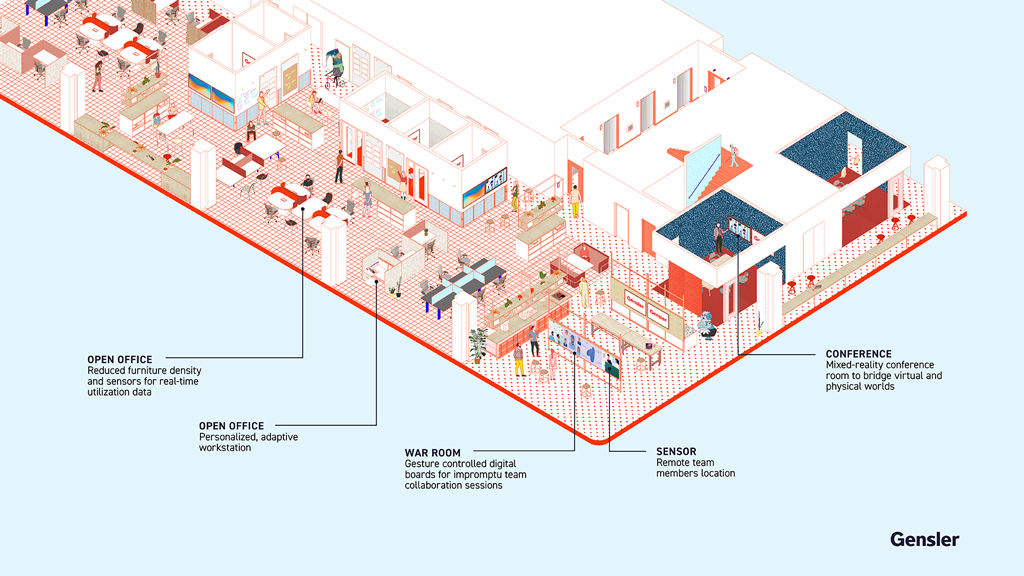The Future Workplace Will Embrace a Hybrid Reality
July 02, 2020 | By Ben Tranel
Editor’s Note: This post is part of our ongoing exploration of how design is responding to the COVID-19 pandemic.
As a result of COVID-19, the workplace will be forever changed. We won’t step back in time, simply “returning” to our former offices. Instead, we will be moving forward to a new place. The hybrid office might look similar in many ways, but it’s going to be modified in strategic ways, incorporating new practices, new protocols, and new technologies.
These changes will take place in response to our heightened concern about disease transmission and the implications for the next pandemic that most certainly will come. They will also incorporate the lessons learned from our extended time working from home, an experience that has opened many people’s eyes to the ways that technology can support us in our work and free us from the office. We’ve also become accustomed to a daily routine that’s absent from the burdens of commuting.
All this adds up to a future in which people will want to work from home more frequently than they did before the pandemic. Despite declarations from some that full-time WFH arrangements will remain after COVID-19 restrictions are lifted, there are many indicators that permanent WFH is not sustainable for culture and talent development, nor is it a replacement for the speed of trust and collaboration that's built through face-to-face work. Collaborative work moves forward at the speed of trust that is built into our relationships.
The Gensler U.S. Work From Home Survey 2020 shows with real data that most people want to return to the office the majority of their week.
So why do employees want to return to the office? Most people want the social connection of being with their peers. According to the Gensler Research Institute, “despite the rapid adoption of virtual collaboration technologies, people still clearly value face-to-face interactions over virtual ones, in many cases, and miss the company of their coworkers.” While WFH has made it possible to keep the momentum for most work functions, it is not a perfect substitute for work that's done together. Given a choice, we would rather be working in person much of the time.
To my mind, what we’re missing and what we’re dying to recapture are those chance encounters that happen every day in office settings. It’s those in-between moments, all the sidebars that happen before and after formal meetings and around the espresso machine. Those are the moments when ideas germinate. They’re when innovation happens. And they’re the stage for the informal social contact that binds us together and builds our office culture. A simple question proves the point: would you start a company with people you had never met in person?
This all begs for a change in how office buildings and the workplace functions. As we start making the transition back to the office, and as we resettle more permanently, the kinds of collaboration, teamwork, and meetings that make up our daily work lives will need to embrace a new “hybrid reality” — a blend of analog and virtual participation that could well redefine how we accomplish work going forward.
What will the new hybrid workplace look like?In April, I wrote a blog post about how we will transition back to the office, noting that in the short term we will enter a “bridge” phase until we know more about the virus. To get prepared for that “bridge,” I suggested that building owners and managers could take several short-term actions, such as rethinking meeting spaces, implementing building-wide cleaning protocols, focusing on indoor air quality, and updating safety measures. Since then, Gensler released a series of concrete recommendations in our “Back to the Office” guide, which outlines return strategies for the workplace and helps frame our conversations with clients.
Office building landlords and tenants — many of our biggest clients — are all trying to figure this out. Issues of health and wellness are driving these conversations. They’re looking at returning between 20% to 80% of their people to the office, gradually increasing the percentage as time passes and we gain more confidence in the safety of the work environment. That means some of their people will be working from home, while others are sitting in a new “de-densified” office with employees spaced farther apart.
As we move across this bridge and approach the other side — our new normal — we have to rethink how to get the best out of each person and give each voice an equal opportunity to be heard. It’s going to require change. When we start returning to traditional office settings, we will find that they are not easily set up for remote participation. So how will the office’s physical environment integrate virtual participants remotely? What kind of interventions will we have to make?
Clearly, we will have to retool the workplace for more virtual collaboration. What will that look like? Will each remote participant have a proxy in the meeting, a kind of avatar that allows them to actively participate with those who are physically present? Will we install more screens in conference rooms? How can we redesign the experience for on-screen participation so that remote workers are not relegated to a lesser status?
It can’t be one-way communication; it must be multidirectional. Groups will gather in virtual porches and virtual pinups. Will virtual reality or augmented reality be part of the mix? There’s no end to what we can imagine in this hybrid reality: integrated digital collaboration tools, next-level conferencing, sensors, and other smart technologies.
Embrace experimentationWhile I envision this hybrid reality stage as an interim solution, it’s going to be a time for experimentation. We will try out new approaches, test different technologies that combine virtual and in-person collaboration, and then carry the successful models of that forward with us.
Some are predicting a drastic paradigm shift in the workplace. But I think many of the fundamentals of office culture will survive. Our research is showing that the social benefits of working together and the sharing of ideas that generate innovation are evergreen concepts.
While the future will look different than the past, what I’m seeing from the WFH experience and hearing in client conversations is this will not lead to a total paradigm shift, but more the incorporation of lessons learned from the months we’ve spent working from home. It’s like we’re adding new tools to our workplace kit of parts — technology tools that will mimic the experience of in-person connections.
We don’t have all the answers yet. But, over the coming year, we are going to keep experimenting and adapting until we get to a place of post-vaccine or post-immunity. We will learn from that experience, and then we will carry something forward into the hybrid experience.
And while we don’t know the ultimate outcome, it will be an interesting experiment. I believe we’re going to come out on the other side with a better work experience for everyone, whether they’re at home or in the office.
For media inquiries, email .

